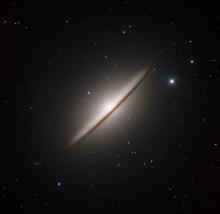Listen to today's episode of StarDate on the web the same day it airs in high-quality streaming audio without any extra ads or announcements. Choose a $8 one-month pass, or listen every day for a year for just $30.
You are here
Future Fireworks
If you happen to be looking at the constellation Cancer in a couple of hundred million years, you might see some fireworks — the merger of two supermassive black holes. Right now, they’re about 750 light-years apart — closer together than any other supermassive black holes within a long way of Earth. They’re spiraling closer to each other, and are expected to merge to form an even bigger black hole.
The black holes are part of a system known as UGC 4211. It’s about 500 million light-years away. Each black hole is more than a hundred million times the mass of the Sun. They’re at the hearts of separate galaxies, which are also merging.
A recent study said the merger should happen in a series of big steps. In the first step, gravitational interactions with stars moving between them will push the black holes closer together. After that, they may keep their distance for a while.
Next, friction with clouds of gas in the galaxies may give the merger a kickstart. And over the final 10 million years or so, the dance of the black holes themselves will produce gravitational waves — ripples in space and time. Those waves carry away energy, which will bring the black holes together — setting off a huge but brief display of fireworks.
Cancer is high in the sky at nightfall. Tonight, it’s above the Moon. UGC 4211 is much too faint to see without a telescope — for now.
Tomorrow: a bright calendar marker.
Script by Damond Benningfield





